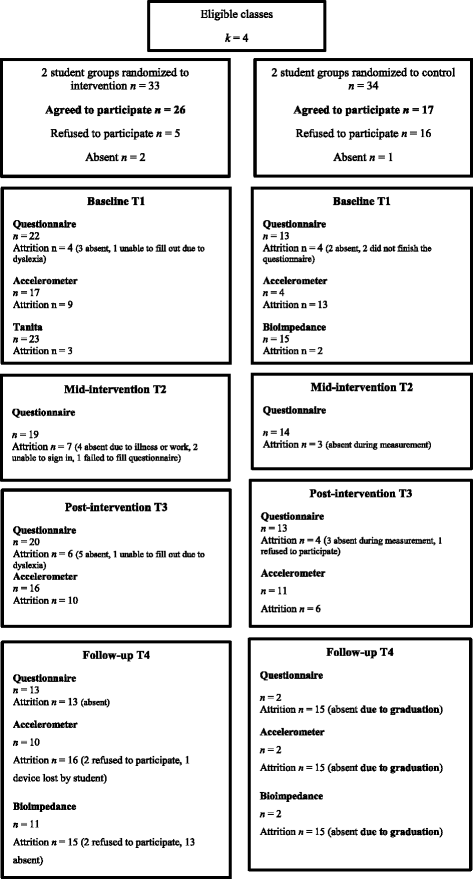Randomised controlled feasibility study of a school-based multi-level intervention to increase physical activity and decrease sedentary behaviour among vocational school students
- PMID: 28327174
- PMCID: PMC5361824
- DOI: 10.1186/s12966-017-0484-0
Randomised controlled feasibility study of a school-based multi-level intervention to increase physical activity and decrease sedentary behaviour among vocational school students
Abstract
Background: No school-based physical activity (PA) interventions among older adolescents have demonstrated long-term effectiveness, and few of them so far have addressed sedentary behaviour (SB). Based on behavioural theories and evidence, we designed a multi-level intervention to increase PA and decrease SB among vocational school students. This study investigates feasibility and acceptability of two main intervention components and research procedures. We also examine uptake of behaviour change techniques (BCTs) by the participants.
Methods: Design was an outcome assessor blinded, cluster-randomised controlled trial. Four classes of students (matched pairs) were randomised into one intervention and one control arm. The intervention consisted of (1) a 6-h group-based intervention for students, (2) two 2-h training workshops to reduce their students' sitting in class for teachers, and (3) provision of light PA equipment in classrooms. At baseline (T1), mid-intervention (T2) at 3 weeks, post-intervention (T3) and 6 months after baseline (T4) we measured hypothesised psychosocial mediators and self-reported PA and sitting. Objective assessment of PA and SB (7-day accelerometry) was conducted at T1, T3 and T4. Body composition (bioimpedance) was measured at T1 and T4. Students and teachers in the intervention arm filled in acceptability questionnaires at T3.
Results: Recruitment rate was 64% (students) and 88.9% (teachers), and at T3, all post-intervention measurements were completed by 33 students (retention 76.7%) and 15 teachers (retention 93.8%). Acceptability ratings of sessions were high (students M = 6.29, scale 1-7), and data collection procedures were feasible. Intervention arm students reported increased use of BCTs, but uptake of some key BCTs was suboptimal. BCT use correlated highly with objective measures of PA. Based on both self-report and student evaluation, teachers in the intervention arm increased the use of sitting reduction strategies at post-intervention and T4 follow-up (p < .05).
Conclusions: We detected willingness of the target groups to participate, good response rates to questionnaires, adequate retention, as well as acceptability of the trial protocol. Investigation of BCT use among students helped further enhance intervention procedures to promote BCT use. After making necessary modifications identified, intervention effectiveness can next be tested in a definitive trial.
Trial registration: ISRCTN34534846 . Registered 23 May 2014. Retrospectively registered.
Keywords: Acceptability; Behaviour change technique use; Feasibility; Pilot trial; Planning; Self-determination theory; Self-regulation; Vocational upper secondary school.
References
-
- Elgar FJ, Pförtner T-K, Moor I, De Clercq B, Stevens GWJM, Currie C. Socioeconomic inequalities in adolescent health 2002–2010: a time-series analysis of 34 countries participating in the Health Behaviour in School-aged Children study. Lancet. 2015;385(9982):2088–95. doi: 10.1016/S0140-6736(14)61460-4. - DOI - PubMed
-
- Hynynen ST, van Stralen MM, Sniehotta FF, Araújo-Soares V, Hardeman W, Chinapaw MJM, et al. A systematic review of school-based interventions targeting physical activity and sedentary behaviour among older adolescents. Int Rev Sport Exerc Psychol. 2016;9(1):22–44. doi: 10.1080/1750984X.2015.1081706. - DOI - PMC - PubMed
-
- Dobbins M, DeCorby K, Robeson P, Husson H, Tirilis D. School-based physical activity programs for promoting physical activity and fitness in children and adolescents aged 6–18. Cochrane Database of Systematic Reviews 2009. 2009(1). doi:10.1002/14651858.CD007651. - PubMed
Publication types
MeSH terms
Associated data
Grants and funding
LinkOut - more resources
Full Text Sources
Other Literature Sources
Medical


